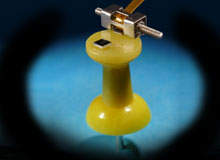
The majority of attention in the medical device field is paid to the effects of new devices on the user’s health.
The mechanical processes that come before the effect may merely be a means to an end, but even the most impressive piece of medical equipment is no more than the sum of its parts. In fact, many devices can achieve amazing medical results thanks to the humble motors, servos and drivers that do all the leg work.
Piezoelectric motors
Piezo motors and actuators harness the piezoelectricity that builds up as a result of pressure applied to particular materials (usually crystals, ceramics or certain natural solids). Piezoelectric actuators are capable of both producing mechanical energy in response to electrical signals and producing electrical signals in response to mechanical stimulus. These innovative motors can be found in a diverse range of medical devices, from surgical equipment and ultrasonic emitters to cell imaging and drug screening applications.
The advantages of piezoelectricity are well-suited to many medical and life sciences functions.
See Also:
In comparison to traditional electromagnetic motors, piezo motors have faster acceleration for faster reaction times, a higher force output/size ratio (making them well-suited to miniaturisation, a significant trend in medical device design) and superior positioning accuracy (piezo motors can hold positions to within a nanometre).
How well do you really know your competitors?
Access the most comprehensive Company Profiles on the market, powered by GlobalData. Save hours of research. Gain competitive edge.

Thank you!
Your download email will arrive shortly
Not ready to buy yet? Download a free sample
We are confident about the unique quality of our Company Profiles. However, we want you to make the most beneficial decision for your business, so we offer a free sample that you can download by submitting the below form
By GlobalDataAs piezo motors contain no rotating parts, there is little need for maintenance or lubrication and service lifetime is almost unlimited.
Until relatively recently, piezoelectric motors were adopted only hesitantly by the medical device industry due to the expense of their research and development. But the technology has now been refined to a point at which commercial production is more viable and manufacturers are increasingly looking to piezo motors to create more reliable, cost-effective equipment.
The technology has become something of an empowering force for the development of new medical devices. In 2001, for example, piezoelectricity was central to the development of ISIS Optronics’ SkinDex 300, the world’s first non-invasive optical scanner for skin diagnostics, combining the benefits of ultrasound and confocal microscopy.
Small is beautiful: medical device miniaturisation
The burden of slashed healthcare budgets on hospitals is fuelling the growth of small, portable medical devices that can be used at home or as outpatient procedures. Procedures that can now be administered outside the hospital include transfusion therapy, dialysis, oxygen therapy, wound therapy and mechanical ventilation.
With their reliability, high acceleration and disproportionate power, piezo motors are ideal for producing high performance from a small platform. The new Squiggle RV, made commercially available in January 2010, takes the piezo motor concept and shrinks it down to a mere 2.8×2.8×6.0mm – the world’s smallest linear motor. And the driver chip is even smaller. According to manufacturer New Scale Technologies, the Squiggle is a quarter of the size of conventional motion control systems, provides comparable output and consumes 40% less power. The company highlights it for use in a field, like portable medical devices, in which precision, small size and low power consumption are a priority.
For New Scale product manager Ralph Weber, the motor is a milestone for the company and for the piezo motor industry. "We are the first company to commercialise a piezoelectric motor system that matches the low voltage operation of stepper motors while at the same time using radically less space and power," he says.
DC motors: brushed or brushless?
For conventional DC motors, two major designs have their own advantages and disadvantages.
The low-cost option is the brushed DC motor, which generally uses a carbon brush to conduct electrical input from lead wires to the commutator. Although the brushed motor is a less expensive option than its brushless counterpart, there are some significant drawbacks.
Brushed motors can achieve a relatively long life cycle if used for an application that requires continuous motion. There are few medical devices that require this, however, with a fairly intensive on/off routine much more typical. The primary shortcoming of brushed motors is that friction between the brush and commutator, combined with electrical arcing on the brush, causes wear, limiting life cycle to around 3,000 hours if used frequently.
The brushless DC motor is a solid advancement of the technology, with the conducting brush and commutator removed and replaced by windings wrapped around poles on a slotted stator. The windings are switched on and off using sold-state electronics. As the wear from brush contact is eliminated, the life of a typical brushless motor is a significant improvement on the brushed motor (typically at least 10,000 hours), while maintaining a comparable output. Brushless motors are also generally quieter, lighter and smaller, giving them another advantage when it comes to miniaturisation for portable medical devices.
The main drawback with brushless motors is that the slotted stators can cause unbalanced magnetic pull, called cogging, as a result of the magnets being more attracted to the stator slots than the gaps between them. The lack of balance in magnetic pull makes producing smooth rotor motion at low speeds and decreases overall motor efficiency.
As a result, manufacturers worked to develop a DC motor that works both without a brush and without stator slots. These brushless, slotless motors combine the smooth motion (if not necessarily the economy) of the brushed motor with the long life of the brushless motor, while eliminating cogging caused by slotted stators. The advantages of this technology can be seen in medical imaging, where brushless, slotless DC motors can reduce banding by allowing smoother operation at lower speeds.



